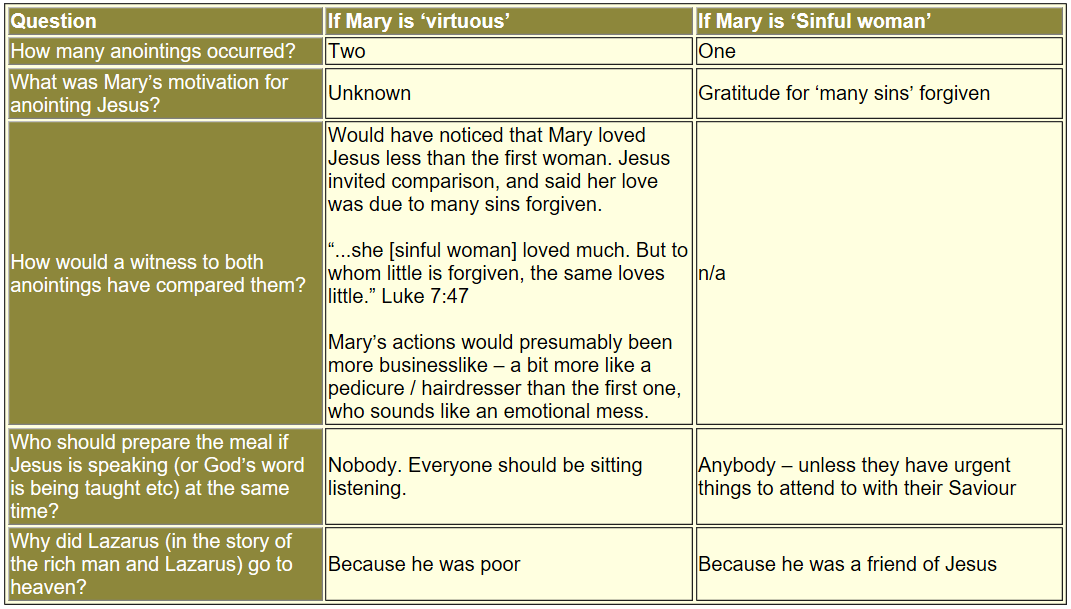I’m doing a talk in a few weeks on the story of ‘the Rich Man and Lazarus’ (Luke 16:19-31), and I find that it fits quite nicely with the account of the raising of Lazarus from the dead in John 11. In particular:
- The name ‘Lazarus’ is used in both accounts without any disambiguation. Usually when more than one person has the same name, we get a surname or other point of identification. Eg. Mary Magdalene, Mary the mother of James, Judas - not Iscariot etc. Here it’s just ‘Lazarus’. Nor is he just a bit player with one or two mentions. Lazarus is named 4 times in Luke 16, and 11 times in John 11-12.
- The story of the Rich Man and Lazarus offers no clue to why Lazarus goes to “Abraham’s bosom” other than that in his lifetime he ‘received bad things’. Are we to understand that everyone who has a tough life goes to heaven? If however we grant him being the Lazarus of John 11, then the answer is clear. Lazarus is identified by his sisters in John 11:3 by “He whom you love is sick”. So he went to heaven because he loved Jesus and Jesus loved him.
- The rich man asks for Lazarus to be sent back to his brothers, and while Abraham is pessimistic about the prospects he doesn’t actually deny the request. And then we find in John 11 that a man called Lazarus is indeed ‘sent back’. And in John 12:10-11, Abraham’s assessment is confirmed – Lazarus’ resurrection results in the chief priests seeking to put him to death again because it’s causing people to believe in Jesus.
One thing that is difficult to reconcile is how Lazarus could be a beggar when a) he was buried in a tomb (John 11:38), and b) his sister Mary produced perfume worth a year’s wages to anoint Jesus (John 11:2; 12:5). However there are three other accounts of this anointing (Matt 26:6-14; Mark 14:3-10; Luke 7:36-50), and in the Luke account the anointer is described as a ‘sinful woman’ (Luke 7:39) – presumably a prostitute. This puts the family in a quite different light. Far from being a well-to-do middle-class family, we see something much grittier. Lazarus is a poor beggar, while his sister Mary makes big money as a prostitute - and apparently doesn’t share with her brother. Yet Jesus met this family and loved them (John 11:5).
This all follows quite naturally, but I find that most commentary on these stories dismisses the possibility that it could be the same Lazarus. So perhaps I’ve missed something important in this, or maybe there are implications that are too uncomfortable for us to accept. Such as:
- It upsets our idea of the Mary who sat at Jesus’ feet (Luke 10:38-41). The usual understanding of her is a pious virtuous woman, listening attentively because it’s the ‘right thing to do’. This interpretation reveals her as a desperate sinner hearing words of grace from her Saviour. Of course she should be excused from meal preparation this time - she has crucial business to do.
- It upsets our idea of who Jesus should love. John 11:5 has “Now Jesus loved Martha and her sister and Lazarus.” It’s a bit disturbing to think of them as a dysfunctional family. We’d much rather see Jesus loving respectable folk. But loving the unlovely is quite in character for Jesus, and complaining about it is quite in character for everyone else. Eg. Matt 11:19; Luke 5:29-30; Luke 15:1-2.
I realise this view is unpopular, but there must be a reason for it. Have I missed something important, or is this simply prejudice?
EDIT: I know there are strong opinions on this topic, but if you’re going to give an answer, ***please provide something based on Scripture rather than unsubstantiated assertions and assumptions***.


